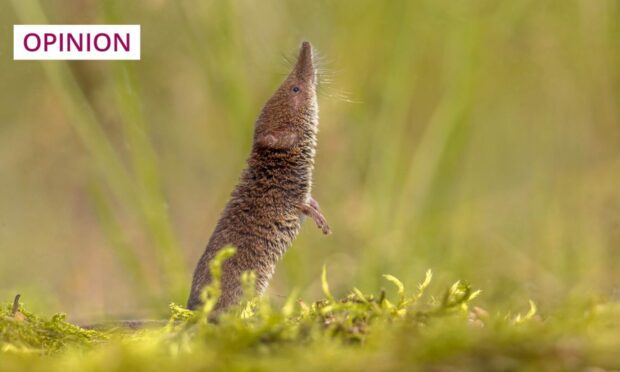How much thought have you devoted to shrews? If you’re anything like me, very little.
Personally, that’s mainly because I rarely get a proper, hard look at one. Out of sight, out of mind.
But that changed recently, when something impossibly small fled from my footsteps in Glen Quoich.
I stopped, sat down on a rock, and kept very still. I expected a small, furry creature to re-emerge, probably a vole, but when it did, a peculiar, long nose announced that it was a shrew.
I’ve encountered shrews before, but they’re usually lying dead on a path. If they’re alive, I tend to hear them rather than see them, as they’re surprisingly vocal. You’ve probably heard them squeaking in undergrowth, without knowing what it was.
But I can’t say I’ve ever given consideration to what species is in front of me. They’re just “shrews”, aren’t they? Nope!
Firstly, it’s easy to lump them in with other small, furry mammals like mice and voles, but shrews aren’t rodents. They’re from an order of mammals called Eulipotyphla, which includes moles and hedgehogs.

Unlike rodents, shrews’ teeth don’t constantly grow, so their enamel instead contains iron to prevent teeth wearing down too quickly. This apparently turns the tips of their teeth orange or red!
There are three species of shrew in Scotland: water, common and pygmy. All shrews have small, almost non-existent eyes, tails, and that distinctive long nose. The snout, covered in ultra-sensitive whiskers, is how they find their way around and locate prey.
The water shrew is our largest species, at 10cm plus tail, and it’s unique among British mammals in having venomous saliva to subdue its prey. The shrew at my feet, however, was beyond small. Its body was tiny, about the length of the upper phalanx of my thumb.
Pale brown, with a white underside and a very long, hairy tail, I’ve since concluded it was a pygmy shrew – at just four grams, the smallest of our shrews and, indeed, alongside the pipistrelle bat, our smallest mammal.
Living at 1,000 beats per minute
I offer this description as though the wee thing sat motionless, allowing me to study it. But it didn’t. Instead, it rushed about at ceaseless high speed, inspecting anything and everything in its path. If it did pause, it was only to jam its long nose under a stone, its rear end comically bouncing up and down as it tried to reach whatever was under there.
It was a fascinating, but I felt utterly exhausted watching. It just didn’t rest.
I wondered how fast its tiny wee heart must beat. For someone my (middle) age, 120 beats per minute would be normal during exercise. That sounds a lot, and certainly feels a lot when your heart is pounding in your chest.
But the pygmy shrew takes things to a whole new level. At the sedate end of the mammalian scale, an elephant’s heart beats at 30 per minute. The blue whale’s is around 10, but can be as little as two per minute on its deep dives. But the pygmy shrew’s heart can beat over 1,000 times per minute – that’s 17 per second!
What would that even sound like? Handily, I located an online metronome for guitar novices that, for reasons unknown, allows you to set it to 1,000bpm. I mean, I know death metal bands employ rapid percussion, but I think even they’d struggle to drum at that speed.
At that speed, it sounded less like a heartbeat and more like a constant trill. Not unlike a grasshopper rubbing (stridulating) its legs together.
Uplifted by a chance encounter
Unsurprisingly, pygmy shrews don’t live long at 1,000bpm. Barely a year. And to fuel their metabolism they must hunt constantly, otherwise they will starve within a couple of hours. This means they eat more than their body weight in woodlice, spiders and small insects every day. Roughly the equivalent of me eating 350 sirloin steaks. Every day!
No wonder this wee shrew was in such a hurry, at one point tumbling blindly over a cliff. Well, a sheer-sided drainage ditch. But it was none the worse for its tumble, and even ran over my boots a couple of times. Clearly, when your life is so short, your legs move faster than your brain, and there’s no time to think about obstacles.
It was actually just 10 minutes, but that’s at least half a day in shrew time
If it was aware of me at all, it certainly didn’t show it, and I sat there watching for ages as it tore around a small area of heath just two metres wide.
Well… it was actually just 10 minutes, but that’s at least half a day in shrew time, so it certainly felt like ages rather than minutes. No wonder I was tired.
I left, uplifted by my encounter. But, as someone who prefers life in the slow lane, I was happy to be back on “me time” rather than “shrew time”.
Ben Dolphin is an outdoors enthusiast, countryside ranger and former president of Ramblers Scotland
